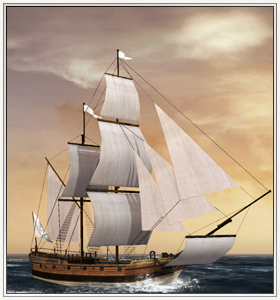Bomb Ketch (ETW unit)
| Bomb Ketch | ||||
|---|---|---|---|---|

| ||||
| Faction: | |
|
| |
| Range: | 750 | 750 | 750 | 750 |
| Accuracy: | 60 | 70 | 60 | 60 |
| Reloading skill: | 20 | 20 | 35 | 30 |
| Hull strength: | 1124 | 1140 | 1176 | 1176 |
| Speed: | 15 | 16 | 15 | 15 |
| Maneuverability: | Low | Low | Low | Low |
| Morale: | 6 | 6 | 7 | 7 |
| Turns to build: | 1 | 1 | 1 | 1 |
| Recruitment cost: | 1190 | 1330 | 1260 | 1225 |
| Upkeep cost: | 290 | 330 | 310 | 300 |
| Requires | ||||
| Technology | ||||
| Explosive Shells | ||||
| Building (minimum level) | ||||
| Dockyard | ||||
The “bomb” is a floating weapons platform, usually adapted from a small, two-masted ketch. The whole ship is constructed around a single large-calibre mortar.
Strongly-built bomb ketches must withstand the recoil of repeated mortar discharges. Often chains replace the rigging ropes nearest the mortar to prevent muzzle blast damage. They are the only naval vessels to carry and use explosive shells, making them a hazardous assignment. As a mark of all their explosive qualities, they often had volcanic names! The fact that the ketch should be at anchor in order to fire accurately also makes them easy targets for any return fire.
Bomb ketches are not good sailing ships. The mortar has to be on the centre line, with a clear vertical field of fire. This means that the masts had to be aft of their ideal positions, making the ship handling qualities rather poor. With these limitations in mind, however, they are a powerful addition to any admiral’s firepower. The ability to deliver shells by indirect fire (lobbing shells into fortifications, for example) is very useful.
Historically, the bomb ketch was a French invention, but other nations perfected the idea. The British mounted the mortar on a rotating platform so that it was no longer necessary to move the whole vessel to change aim. “The Star-Spangled Banner”, the US national anthem, commemorates these ships with the line “the bombs bursting in air.”
Available for:
| |
|
|
|
|
|
| |
|
|
|
|
|
